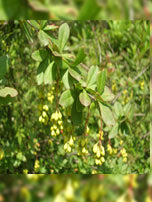SHAHEED KARTAR SINGH SARABHA AYURVEDIC MEDICAL COLLEGE & HOSPITAL
Affiliated to Guru Ravidas Ayurved University, Hoshiarpur Punjab
Affiliated to Guru Ravidas Ayurved University, Hoshiarpur Punjab

Botanical Name : Berberis aristata DC.
Family : Berberidaceae.
Introduction :
Usually ‘Dãruharidrã’ along with Haridrã uses external application. Cocinium fenestratum (MENISPERMACEA) is used in South India as Dãruharidrã but in North India Berberis aristata uses as Dãruharidrã.
Scientific classification: Barberries make up the family Berberidaceae. The representative genus is Berberis. The common barberry is classified as Berberis vulgaris, the American barberry as Berberis canadensis, and the Colorado barberry as Berberis fendleri. The Japanese barberry is classified as Berberis thunbergii, the Magellan barberry as Berberis buxifolia, and the wintergreen barberry as Berberis julianae.IndianBarberries as Barberies aristata.
Names in different Indian languages :
English : Indian Barberry
Hindi : Jhar –i-haldi
Kannada : Maradasina
Malayalam : Maramannal
Sanskrit : Daruharidra, darvi
Tamil : Maramancal, mancalkoti
Telugu : Manu pasupu
Unani : Daarhald, Rasaut (extract), Zarishk (fruit).
Synonyms :
Pitachandana, Pitasaara, Harichandana, Kaaliyaka, Kalambaka, Daaruharidraa, Daaru, Daarvi, Daarunishaa, Daarurajani, Vrahitaphala, Valliphala, Sthirphala. Pushpaphala, Somakaa, Parjanyaa, Parjani, Kantkateri, Taarthya, Pachampachaa. Kaaliyaka
Berberis asiatica Roxb. ex DC
Classification according to Charaka, Susrutha & Vagbhata :
Charaka
Arsoghna, Kandüghna, Lekhaniya Läksadi
Susrutha
Haridrãdi, Mustadi
Vagbhata
Haridrãdi, Mustadi
Varieties & adulterants – (CV – controversy, AD – adulterants) :
Plants using in South India & North India are well identified, there is no confusion of this two drugs.
(1) The rocky mountain group B. aquifolium Pursh
(2) Dãruharidrã – The Asiatic group i.e.; B. aristata
(3) The European group i.e.; B. vulgaris Linn.
(4)Berberis chitra.
(5)Berberis lycium.
(6) Kãliyaka – Cosinium fenestratum – South India
Berberis actinacantha
Berberis wilsonae
Berberis ottawensis
Morphology :
A large deciduous shrub, 2-3.6m high. Twigs whitish or pale yellowish brown,
Leaves- simple, 4-10 cm by 1.5-3 cm, obovate or elliptic, entire or toothed, base gradually narrowed, dark green above, pale beneath. Petiole 0-3 mm.
Inflorescence a simple drooping raceme, 3-6 cm. long. Densely flowered.
Fruit 7- 10 mm. long, ovoid, blue-black, distinct style.
Distribution & Habitat :
Northwestern Himalayas, Nilgiris, Kulu and Kumaon
Chemical constituents :
Berberine hydrochloride and sulphate, Berberine, Karachine (a protoberberine alkaloid), taxilamine, berberine, palmatine,jatrorrhizine, oxycanthine,
Properties :
Rasa Tikta, Kasaya
Guna Laghu, Rüksa
Virya Usna
Vipäka Katu
Karma :
Kapha-pittahara, Chedana, vranahara, varnya
stomachic, diuretic, hypotensive, antidysenteric, antibacterial, antifungal, bitter tonic in dyspepsia and debility.
Indication :
Prameha, Kustha, Netra roga, veta pradara, Kãmalã, Vrana, Visarpa
Fractures, for dressing wounds and ulcers, cutaneous leishmaniasis.
Part used :
Root, Stem, Fruit – extract (Rasãnjana)
Dosage :
Decoction 50-100ml;
fruit powder 5-l0g; extract-3g.
External uses :
Reduces inflammation or oedema. removes pain, cures and heals ulcers, also used for eye diseases like conjunctivitis, as rasajana
Internal uses :
Digestive system : liver stimulant. A larger dose is laxative. The fruit is very tasty. Daruharidra is a superior medicine in agnimandya, dysentery, jaundice and other liver disorders.
Circulatory system : Blood purifier and haemostatic agent. haridra acts on rakta dhatu.
Respiratory system : It is useful in the treatment of cough
Reproductive system : Useful in uterine inflammations and vaginal discharges.
Skin : Daruharidra decoction is useful in cleaning wounds. . It is useful in ulcer.
Temperature : Diaphoretic and is a prophylactic treatment for typhoid, hence it is useful in common fever This preserves and increases the patient’s strength
Important Yogas or Formations :
Darvyadikwath, Darwadilaila. Rasanjanshuddhi Rasanjan
Therapeutic Uses :
(1) svëta pradara- Decoction of Dãruharidrã is given with honey (G.N.)
(2) meha- Decoction of Haridrã and Dãrtiharidrä is useful (S.S.Ci.)
(3) Vriddhi (kaphaja)- Däruharidrä paste is taken with cow’s urine (Vr.Mã.)
(4) Mütrákrichra- Juice of Dãruharidrã and Amalaki with honey (C.SCi.26)
